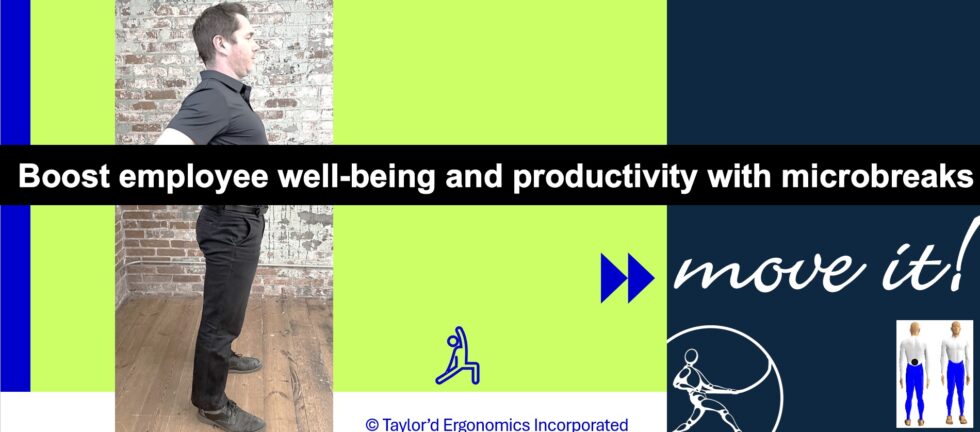If your workplace has toyed with the idea of a pre-shift stretching program, please read on. We just launched our “Move-it!” package, which is a very flexible set of materials, designed to be implemented as a microbreak activity program. Today I want to talk about:
- What are microbreaks?
- What type of activities make good breaks?
- How will we know if it works?
A few weeks ago, I talked about how important it is for us to measure the effectiveness of our solutions. A few months ago, I talked about how an ideal workplace microbreak program would incorporate more than stretching. Today, I want to talk about both.
- What are microbreaks?
Microbreaks are, by definition, interruptions in repetitive or sustained work that allow the body to re-calibrate itself. These breaks are typically only a few seconds long, but can be longer when the opportunity presents itself. Research published by NIOSH showed that microbreaks reduce fatigue, improve vigour, and improve performance and well-being. In their review of literature, NIOSH included studies that provided physical or cognitive breaks from work, ranging between 8 seconds and 10 minutes. The studies NIOSH reviewed took place either in a lab environment (at a university) or in workplaces including office or nursing. A 2023 Canadian study by Karla Beltran Martinez and her colleagues at the University of Alberta showed that 1-minute microbreaks during repetitive manual work reduced fatigue and had no significant effect on productivity. (Subjects experienced less fatigue while still getting the work done. Fatigue is widely used as a stand-in for strain/sprain injury risk.)
Many workplaces require workers to maintain a steady pace throughout the day. Martinez’s research suggests that workers can keep up with the assigned work while improving their comfort using intermittent microbreaks.
- What types of activities make good breaks?
Until recently, workplace break or warm up programs focused exclusively on stretching. And while stretching is one component of the “fitness” equation, Dwayne Van Eerd and his colleagues at IWH (another Canadian institution) reported in 2015 that “a workplace-based resistance training exercise program can help prevent and manage UEMSD [Upper Extremity Musculoskeletal Disorders] and symptoms.” They also reported some evidence that stretching programs are effective.
I’ve been reading Howard Luks’ book “Longevity Simplified”, and I felt that, in addition to strength and flexibility activities, balance and mobility training should also be integrated into the program. I referenced Dr. Luks in a previous blog, which summarized his approach to living healthy, for longer. We agree with Luks that cardiovascular activity is also important, but we couldn’t figure a way to build that into a microbreak program.
Finally, for good measure, we know that our eyes take a beating at some jobs, and they also deserve a break. The 20-20-20 rule has been around for a long time: look at least 20 feet away, for a 20 second break from prolonged visual demands, every 20 minutes. We’ve amped up the variety; yes, looking away is still one of the vision breaks, but we’ve added more!
In summary, we believe that an effective microbreak program will include stretch, strength, mobility, balance, and visual break activities.
- How will we know if it works?
Whether you buy into the research or not, we strongly encourage our clients to seek baseline and follow up measures of employee discomfort, productivity, engagement, and work quality. To this end, every client that purchases the program will be provided with a link to a survey, which employees can complete before the program launches, and after. The data comes to us, is anonymized, and a summary of the program’s effectiveness will be provided to the client. We hope to share some overall stats about the program in future conference presentations.
To enhance program effectiveness, we also offer an in-person, 2-hour training program for client-selected program champions. We’ll literally prove to these champions, through hands-on activities, how each of the categories of “Move-it!” activities works, and how it enhances wellbeing. These champions can then launch and lead the roll-out of the program, determining the best way for their organization to deliver and maintain awareness of the program.
Curious? To our knowledge, this is the only package that includes more than stretch and strength activities. You can purchase the program (and optional training) for one site, here. If you’re interested in a corporate license, please contact carrie@taylordergo.com. I’m here to answer your questions and help you get started!


